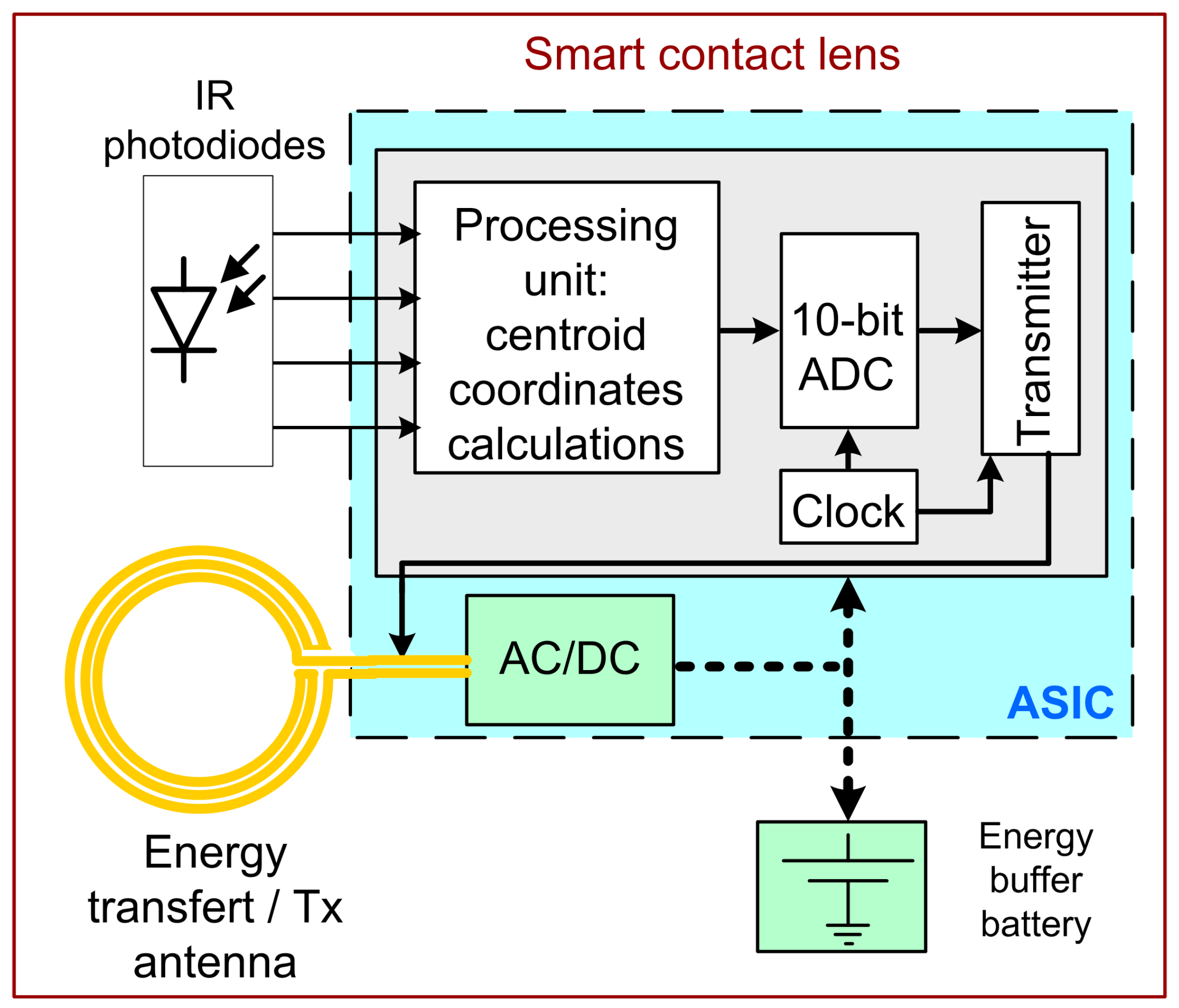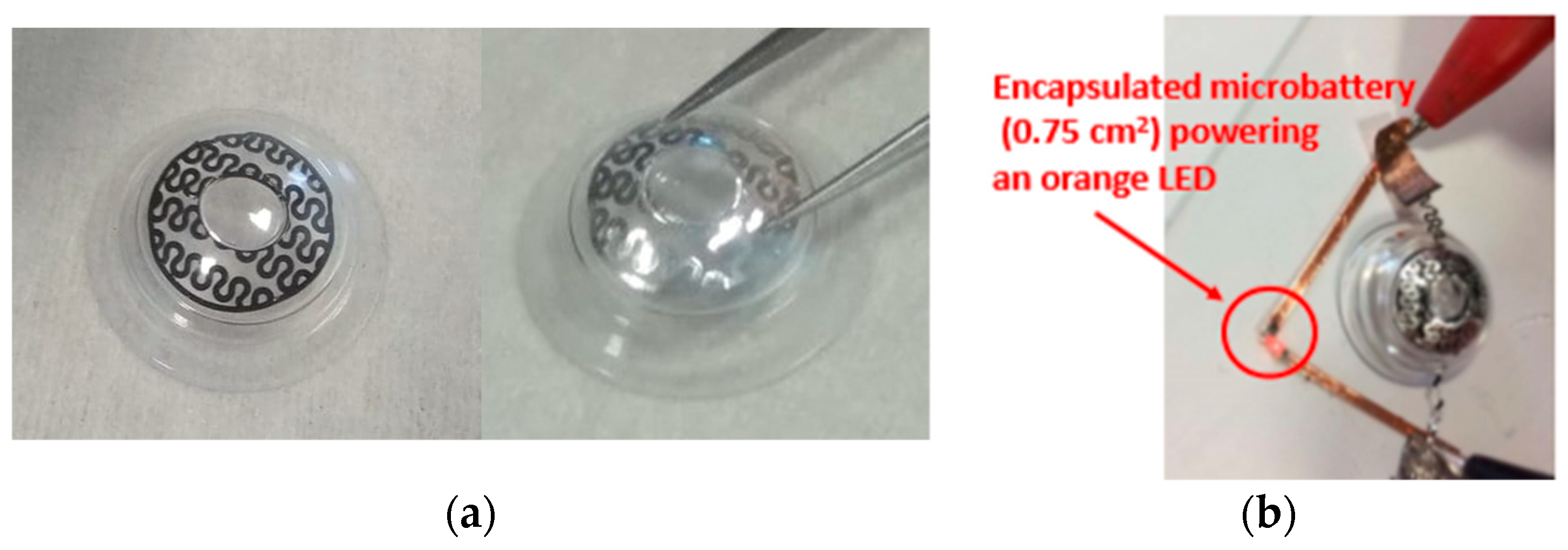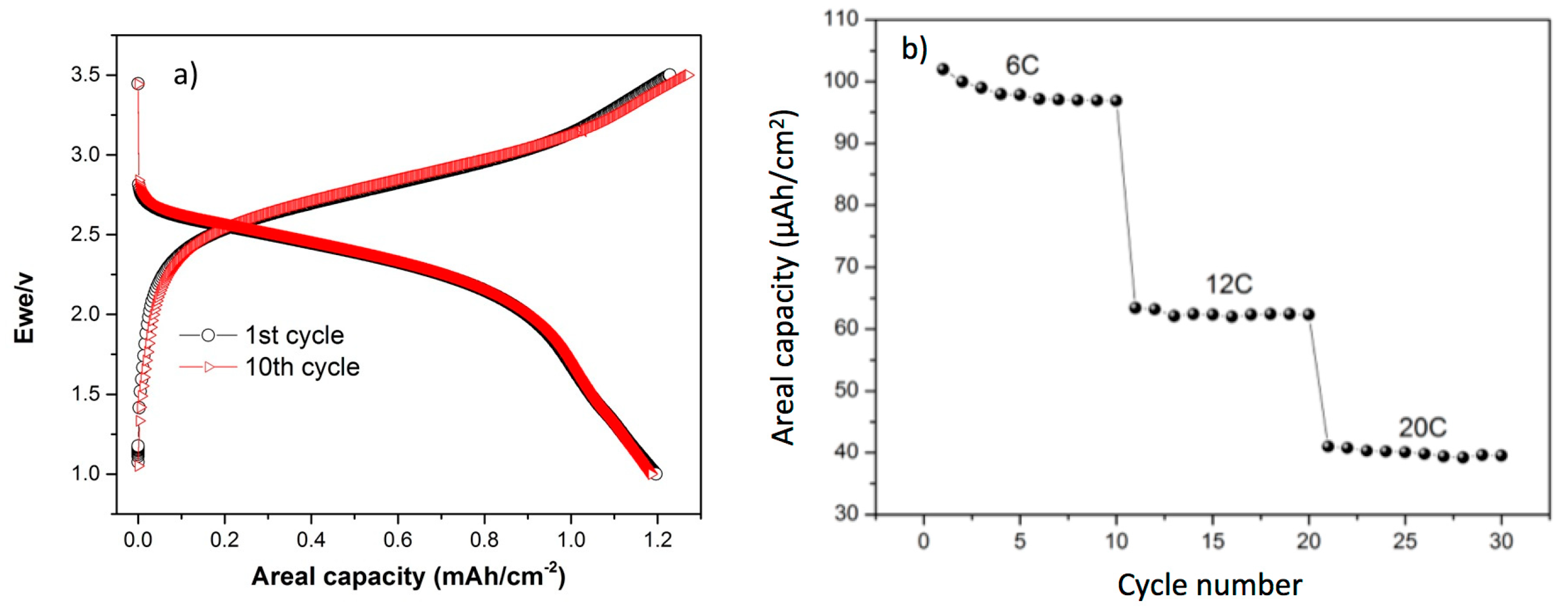Flexible Micro-Battery for Powering Smart Contact Lens
Abstract
1. Introduction
2. System Power Needs and Battery Requirements
2.1. Eye-Tracker Case
2.2. Power Modes and RF Energy Harvesting
2.3. Battery Dimensioning and Requirements
3. Principle of Encapsulation in a Scleral Contact Lens
4. Micro-Battery Design and Fabrication
5. Measurements and Tests
6. Discussions and Conclusions
Author Contributions
Funding
Acknowledgments
Conflicts of Interest
References
- Farandos, N.M.; Yetisen, A.K.; Monteiro, M.J.; Lowe, C.R.; Yun, S.-H. Contact lens sensors in ocular diagnostics. Adv. Healthc. Mater. 2015, 4, 792–810. [Google Scholar] [CrossRef] [PubMed]
- Chiou, J.-C.; Hsu, S.-H.; Huang, Y.-C.; Yeh, G.-T.; Liou, W.-T.; Kuei, C.-K. A wirelessly powered smart contact lens with reconfigurable wide range and tunable sensitivity sensor readout circuitry. Sensors 2017, 17, 108. [Google Scholar] [CrossRef] [PubMed]
- Sensimed, A.C. Triggerfish. Available online: http://www.sensimed.ch/fr/ (accessed on 1 April 2019).
- De Bougrenet de la Tocnaye, J.L.; Dupont, L.; Ferranti, F.; Lahuec, C.; Nourrit, V.; Seguin, F.; Adam, L. A Wireless Contact Lens Eyetracking System: An Example of Smart Sensors Development Platform. In Proceedings of the 5th International Conference SENSO, Gardanne, France, 15 November 2017. [Google Scholar]
- Tremblay, E.J.; Stamenov, I.; Beer, R.D.; Arianpour, A.; Ford, J.E. Switchable telescopic contact lens. Opt. Express 2013, 21, 1590–1598. [Google Scholar] [CrossRef] [PubMed]
- Blum, Z.; Pankratov, D.; Shleev, S. Powering electronic contact lenses: Current achievements, challenges, and perspectives. Expert Rev. Ophthalmol. 2014, 9, 269–273. [Google Scholar] [CrossRef]
- Lingley, A.R.; Otis, B.P.; Sheng, T.T.; Parviz, B.A. A contact lens with integrated micro solar cells. Microsyst. Technol. 2012, 18, 453–458. [Google Scholar] [CrossRef]
- Sano, C.; Mitsuya, H.; Ono, S.; Miwa, K.; Toshiyoshi, H.; Fujita, H. Triboelectric energy harvesting with surface-charge-fixed polymer based on ionic liquid. Sci. Technol. Adv. Mater. 2018, 19, 317–323. [Google Scholar] [CrossRef] [PubMed]
- Le Goff, A.; Holzinger, M.; Cosnier, S. Recent progress in oxygen-reducing laccase biocathodes for enzymatic biofuel cells. Cell. Mol. Life Sci. 2015, 72, 941–952. [Google Scholar] [CrossRef] [PubMed]
- Ng, B.; Heckler, P.; Do, A.; Azar, P.; Leon, E.; Smilkstein, T. Antenna and coil design for wireless signal detection and charging of embedded power active contact lens. In Proceedings of the 36th Annual International Conference of the IEEE Engineering in Medicine and Biology Society, Chicago, IL, USA, 26–30 August 2014; pp. 5956–5959. [Google Scholar]
- Massin, L.; Lahuec, C.; Nourrit, V.; Seguin, F.; de Bougrenet de la Tocnaye, J.L. Towards accurate camera-less eye trackers using instrumented contact lens. In Proceedings of the 17th IEEE International New Circuits and Systems Conference, Munich, Germany, 23–26 June 2019. [Google Scholar]
- Chamorro, J.P.; Lahuec, C.; Seguin, F.; Jézéquel, M. Design rules for subthreshold CMOS circuits. In Proceedings of the 5th Analogue Decoding Workshop, Torino, Italy, 5–6 June 2006; pp. 23–26. [Google Scholar]
- Lhermet, H.; Condemine, C.; Plissonnier, M.; Salot, R.; Audebert, P.; Rosset, M. Efficient power management circuit: From thermal energy harvesting to above-ic microbattery energy storage. IEEE J. Solid-State Circuits 2008, 43, 246–255. [Google Scholar] [CrossRef]
- Shi, Q.; He, T.; Le, C. More than energy harvesting combining triboelectric nanogenerator and flexible electronics technology for enabling novel micro-/nano-systems. Nano Energy 2019, 57, 851–871. [Google Scholar] [CrossRef]
- Nasreldin, M.; Delattre, R.; Marchiori, B.; Ramuz, M.; Maria, S.; de Bougrenet de la Tocnaye, J.L.; Djenizian, T. Microstructured electrodes supported on serpentine interconnects for stretchable electronics. Appl. Phys. Lett. Mater. 2019, 7, 031507. [Google Scholar] [CrossRef]
- Marchiori, B.; Delattre, R.; Hannah, S.; Blayac, S.; Ramuz, M. Laser patterned metallic interconnections for all stretchable organic electrochemical transistors. Sci. Rep. 2018, 8, 8477. [Google Scholar] [CrossRef] [PubMed]
- Chen, Y.; Kushner, A.; Williams, G.; Guan, Z. Multiphase design of autonomic self-healing thermoplastic elastomers. Nat. Chem. 2012, 4, 467. [Google Scholar] [CrossRef] [PubMed]





| Estimated harvested RF power * (mW) | ≈2 |
| Simulated consumed ASIC power (mW) | |
| Processing unit | 0.043 |
| Analog to Digital Converter | 0.015 |
| Clock oscillator | 0.1 |
| RF transmitter | 0.7 |
| Discharge Rate | C/10 | 6C | 12C | 20C |
| Discharge Time (min) | 600 | 10 | 5 | 3 |
| Areal Capacity (µAh·cm−2) | 1200 | 98 | 63 | 43 |
| Capacity (µAh) | 900 | 73.5 | 47 | 32 |
| Delivered Current (µA) | 90 | 441 | 564 | 640 |
| Energy Density (µWh) | 2295 | 187 | 120 | 81 |
| Power Density (µW) | 229.5 | 1125 | 1438 | 1632 |
© 2019 by the authors. Licensee MDPI, Basel, Switzerland. This article is an open access article distributed under the terms and conditions of the Creative Commons Attribution (CC BY) license (http://creativecommons.org/licenses/by/4.0/).
Share and Cite
Nasreldin, M.; Delattre, R.; Ramuz, M.; Lahuec, C.; Djenizian, T.; de Bougrenet de la Tocnaye, J.-L. Flexible Micro-Battery for Powering Smart Contact Lens. Sensors 2019, 19, 2062. https://doi.org/10.3390/s19092062
Nasreldin M, Delattre R, Ramuz M, Lahuec C, Djenizian T, de Bougrenet de la Tocnaye J-L. Flexible Micro-Battery for Powering Smart Contact Lens. Sensors. 2019; 19(9):2062. https://doi.org/10.3390/s19092062
Chicago/Turabian StyleNasreldin, Mohamed, Roger Delattre, Marc Ramuz, Cyril Lahuec, Thierry Djenizian, and Jean-Louis de Bougrenet de la Tocnaye. 2019. "Flexible Micro-Battery for Powering Smart Contact Lens" Sensors 19, no. 9: 2062. https://doi.org/10.3390/s19092062
APA StyleNasreldin, M., Delattre, R., Ramuz, M., Lahuec, C., Djenizian, T., & de Bougrenet de la Tocnaye, J.-L. (2019). Flexible Micro-Battery for Powering Smart Contact Lens. Sensors, 19(9), 2062. https://doi.org/10.3390/s19092062






